Ijraset Journal For Research in Applied Science and Engineering Technology
- Home / Ijraset
- On This Page
- Abstract
- Introduction
- Conclusion
- References
- Copyright
Fiber Optics Communication: Evolution of Guided Media
Authors: Aarti Varshney, Vishal Goyal
DOI Link: https://doi.org/10.22214/ijraset.2024.58076
Certificate: View Certificate
Abstract
Fiber Optic Communication system is a key element in modern day telecommunication network used all around the globe. Larger bandwidth signal transmission where data received with lowest possible delay serves as a big edge to both, the telecommunication industry and consumer. Recently, optical fiber communication technology has made great progress, where constantly exploring new technologies has greatly enhanced communications capabilities in the traditional sense. This paper gives an overview of fiber optic communication systems including their key technologies, and also discusses their technological trend towards the next generation. The recent developments in the area of fiber optic communication as well as the advances in different Fiber types, their properties, optical sources, detectors, system limitations and applications are also discussed in the paper.
Introduction
I. INTRODUCTION
A strong motivating force behind telecommunications research is the desire of reliable and economical transmission media with large information carrying capacity. Fiber optics communication is a technique used for transmitting signals/information from one point to another by directing infrared light pulses as electromagnetic carrier waves through an optical fiber. The information transmitted with this technology can be voice, video, and telemetry i.e. basically digital information generated by telephone systems, cable television companies, and computer systems which will further transmit through LANs, computer networks, or across long distances. Information is modulated with pulse of light that serves as an electromagnetic carrier wave send down a glass tube over a long distance with very little attenuation or loss. This modulated pulse of light propagates through the glass tube using the principle of (TIR) total internal reflection [1].
An optical fiber is a dielectric cylindrical waveguide created from low-loss materials, commonly silicon dioxide. It is made up of three centered parts namely as outer coat, core and its cladding. The core is the light-carrying portion of the fiber which is usually made of glass or plastic. Cladding surrounds the core and made of a material with a slightly lower refraction index than core. Buffer is the outer layer to protect the core and cladding from damage and it serves as a shock absorber. The coating usually comprises one or more coats of a plastic material to protect the fiber from the physical environment. In some of the fiber optics cable, there may be metal dressing referred as sheath which provides further physical safeguarding. This difference in the indices causes total internal reflection to occur at the core-cladding boundary along the length of the fiber. Light is transmitted down the fiber and does not escape through the sides of the fiber.
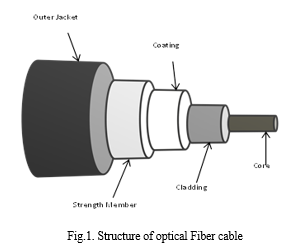
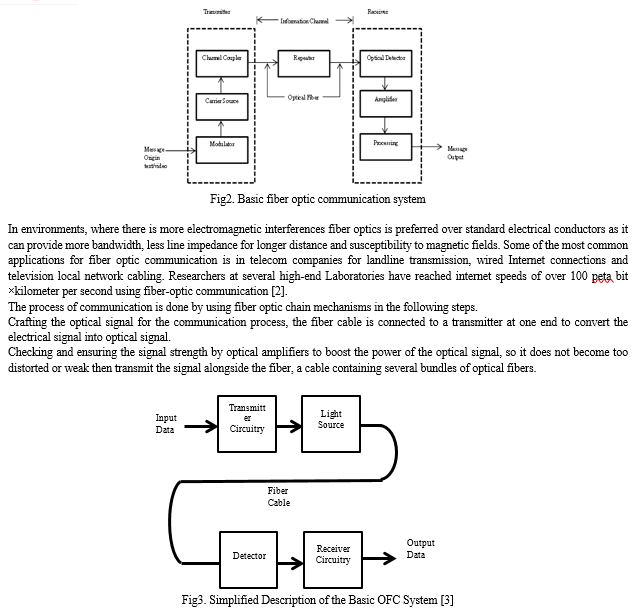
Receiving the optical signal and converting it into an electrical signal at the other end, the fiber cable is plugged into a receiver which decodes the optical signal back into electrical signal.
Latency - The time it takes for a signal to be transmitted over a channel. This includes encoding time, travel time, and decoding time.
II. EVOLUTION OF FIBER OPTIC COMMUNICATION
Optical fiber was first developed by Corning Glass Works in 1970 and to conduct light through the fiber optic cables GaAs semiconductor lasers were correspondingly established at the same time. The first generation of fiber optic communication was developed in 1975, it uses GaAs semiconductor lasers, Operating wavelength region near to 0.8 μm with other specifications of this generation are bit rate of 45Megabits/second and allowed repeater spacing up to 10 km. Such systems became available commercially in 1980 after several field trials during the period (1977–79).
Being able to support line distance of 10km for a coaxial system became a turning point for these designers, as it removed the cost of installation of more repeaters and their maintenance.
The second generation of fiber optic communication offered in the early 1980’s; which used InGaAsP semiconductor lasers and operated at a wavelength of 1.3 μm. These initial systems were restricted to provide bit rate below 100 Mb/s due to dispersion in multimode fibers [25]. This limitation was overcome by the use of single-mode fibers after successful experiment done in 1981 which established transmission at 2 Gb/s over 44 km of single-mode fiber. Through 1987, second-generation light wave systems were commercially available which operating at bit rates of up to 1.7 Gb/s with a repeater spacing of about 50 km.
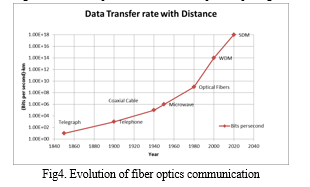
The third generation of fiber optic communication became available in 1990. These light wave systems operating at a wavelength of 1.55 μm and capable of working at a bit rate of up to 2.5 Gb/s [26] with 100Km repeater spacing. Dispersion shifted fibers are used with lasers oscillating in a single longitudinal mode to attain best performance. A drawback associated with these systems is that the signal is regenerated periodically by using electronic repeaters spaced apart typically in 60–70 km.
The fourth generation of fiber optic systems made use of optical amplifiers to increase the repeater spacing, and employed wavelength division multiplexing (WDM) to increase data rates [4]. Through 1996, transmission over 11,300 km at a bit rate of 5 Gb/s had been validated by using actual submarine cables [27], as well as commercial transatlantic and transpacific cable systems also became accessible.
The fifth generation of fiber-optic communication systems is concerned for extending the wavelength range which successfully done with Dense Wave Division Multiplexing (DWDM)[5]. The conventional wavelength window covers the wavelength range 1.53–1.57μm, which known as the C band. It is being extended on both the long- and short-wavelength sides, resulting in the L and S bands, respectively. The Raman amplification technique can be used for signals in all three wavelength bands. Moreover, a new kind of fiber, known as the dry fiber has been developed with the property that fiber losses are small over the entire wavelength region extending from 1.30 to 1.65. Also there was an exploration being done on optical solitons which prevents any optical field change during transmission.
Table 1: Evolution of fiber optic communication [5]
|
Specifications |
1st |
2nd |
3rd |
4th |
5th |
|
Semiconductor |
GaAs |
InGaAsP |
|
WDM technique |
Roman amplification technique and optical solitiors. |
|
Operating region |
0.8 μm |
1.3 μm |
1.55 μm |
1.45 -1.62 μm |
1.53 -1.57 μm |
|
Bit rate |
45Mb/s |
100 Mb/s - 1.7 Gb/s |
10 Gb/s |
10 Tb/s
|
40 - 160 Gb/s |
|
Repeater spacing |
10km |
50 km |
100Km |
> 10,000 km |
24000- 35000 km |
III. TYPES OF FIBER OPTICS
Optical fiber is categorized into two sets based upon the number of modes, and the refractive index.
A. Based On Number Of Propagation Modes
Based on number of propagation modes:, Where mode is concept to delineate fiber optics propagation nature for electromagnetic waves inside a waveguide. Mode means the nature of the electromagnetic field pattern (or) configuration along the light path inside the fiber [6]. It is classified into 2 types:
1) Single-Mode Fiber
It allows only a single path for the light ray traveling through i.e. Only one type of ray of light can promulgate through the fiber. This type of fiber comprises a small core diameter of 5um with high cladding diameter of 70um and having very small difference between the refractive indexes of them. A laser diode is used to pass the light through it. There is no signal degradation during traveling through the fiber.
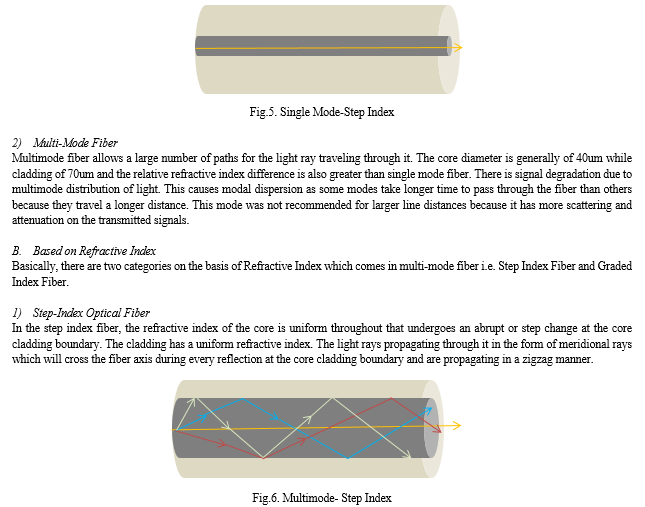
2) Graded Index Optical Fiber
In this type of fiber, Graded-index denotes to the fact that the core has a non-uniform refractive index that gradually decreases from the center towards the core-cladding interface; the refractive index of the core is made to vary in the parabolic manner such that the maximum value of refractive index is at the Centre of the core.
The cladding has a uniform refractive index. The light rays propagate through it in the form of skew rays or helical rays which will not cross the fiber axis at any time. Because of higher scattering and bending of light signals at the center of core, the speed of light rays decreases. Due to this all the light rays get to the receiver end in approximately same time.
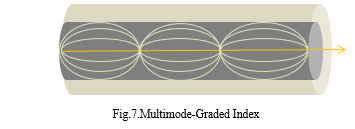
IV. ADVANTAGES OF OPTICAL FIBER COMMUNICATION
A. Wider Bandwidth
The capacity of information carrying in a transmission system is directly proportional to the carrier frequency of the transmitted signals. The radio wave frequency is about 106 Hz and the microwave frequency is about 1010 Hz while the range of optical carrier frequency is (1013-1015 ) Hz. Consequently, the optical fiber produces greater transmission bandwidth than the conventional Cable based communication systems and amount of information that can be transmitted per second is increased to a greater extent in the optical fiber communication system which it’s most significant advantage. The possible Transmission rate in optical fiber is 10GB/sec while 1GB/sec in coaxial cable. Further, the bandwidth can enhance to many orders of magnitude by the wavelength division multiplexing process.
B. Small size and weight
Fiber optic cables are established with small radii. They are compact and lightweight with capability of carrying a large number of signals. The optical fiber cables are superior in compare to the copper cables in terms of installation, transportation, handling, storage, durability and maintaining comparable strength.
C. Ease of Installation
It is easy to install and compatible with digital technology. The grounding and protection are not necessary as the fiber optic has no electrical conductivity.
D. 4.4. Immunity to Noise
Fiber optic cables are immune to electromagnetic interference, while a telephone wires losses some of its signal to another. It can also be run in electrically noisy environments deprived of any concern as electrical noise will not affect fiber.
E. Safe to use
It cannot shock or other hazards due to lack of electrical signals in the fiber which makes fibers suitable for work in explosive atmospheres. Fiber is non-conductive in nature so no electron flows happen through it whereas copper is best conductor for electrical current which makes it prone to fire if worn out or poorly shielded.
F. Signal security
Optical fibers are difficult to tap. Emissions cannot be intercepted as they do not radiate electromagnetic energy and physically tapping of the fiber takes great skill to do undetected. Due to that reason optical fiber communication provides secure transmission for carrying sensitive data.
G.. Low Power Loss
An optical fiber affords low power loss, which allows for longer transmission distances. In comparison to copper, the longest recommended copper distance in a network is 100m while with fiber, it is 2km.
H. Flexibility
Tensile strength of an optical fiber is greater than copper or steel fibers of the same diameter. They are flexible so can be bent and twisted easily without any damage. They resist most corrosive elements that attack copper cable.
I. Cost
The raw materials for glass are plenteous, unlike copper i.e. glass can be made more cheaply than copper [7].
V. OPTICAL FIBER LIMITATIONS
- The bend radius of optical fiber cables is limited (about 30 mm). So, if they are bent beyond the limitations, it may lead to some signal loss [2]. But nowadays, bend resistant fibers are launched that have high tolerance control for bending.
- Optical fiber cables have many types of connectors unlike Copper UTP cables which have standard mostly Rj-45 Jacks and connectors. The lack of standardization adds confusion.
- Some leakage of signal could be induced due to bending the optical fiber cables which can be used for hacking the information in them. So, they are not totally tamper-proof even though doing that might be difficult.
- Single mode cables and their associated active components are very expensive. However multi-mode cables and their optics are less expensive, but still, they are not close to the cost of copper UTP cables/ ports. Moreover, multi-mode cables have restrictions in distance for supporting higher bandwidth (like 1 Gbps and 10 Gbps).
- The Fiber cables for outdoor requires proper shielding which makes them less flexible to run in all the places but it increases the overall cost of cables.
- Fiber splicing, a complicated procedure requires skilled manpower to achieve. If it will not do properly, it might lead to degrade the performance [].
- Fiber network implementation requires a whole array of active/ passive components (SFP Modules, Fiber Patch Cords), appropriate connectors and Couplers as they cannot be directly sacked on to the network/ optical switches. All these components increase the cost of fiber network implementation at each location.
VI. APPLICATIONS OF OPTICAL FIBER COMMUNICATIONS
Fiber optic cables are used in most of the industries. Some uses of fiber optic cables include:
|
Field |
Applications
|
|
Medical |
Used as light guides
imaging tools and
as lasers for surgeries
|
|
Defense/Govt. |
as wiring in aircraft and other vehicles
for field networking
Used as hydrophones for seismic waves and SONAR ,
Used in sub-marine cable networks
|
|
Networking |
Used to connect users and servers in a variety of network settings
|
|
Telecommunications |
Used for transmitting and receiving purposes
|
|
Data Storage |
Used for data transmission
|
|
Industrial/Commercial |
Used for imaging in remote areas,
As wiring in automobiles and industrial settings and where EMI is an issue,
As sensory devices to make temperature, pressure and other measurements
|
|
Broadcast/CATV |
Broadcast/cable companies are using fiber optic cables for wiring CATV, HDTV, internet, video on-demand and other applications
Fiber optic cables are used for lighting and imaging and as sensors to measure and monitor a vast array of variables. Fiber optic cables are also used in research and development and testing across all the above-mentioned industries
Used in data link for computer networks, CATV Systems.
|
|
Other |
Used for connecting fire, police, and other emergency services. Used in traffic management systems. Used in heavy duty constructions.
|
Table 2: Applications of Optical Fiber Communications
VII. COMPARATIVE STUDY
This comparative study of fiber, copper and wireless technologies has been presented. This study presented the difference between all technologies under 10 key factors as presented in table 3. to understand why Fiber optics has revolutionized the communication industry is by understanding the trend changes that are brought in the design and usage in communication and network industry.
|
Parameter |
Fiber |
Copper |
Wireless |
|
Transmission |
Data transmits in the form of light. |
Data transmits in the form of electrical signals.
|
Data transmits in the form of electrical signals. |
|
Structure |
It is very thin and lightweight. |
It is very thick and heavier. |
It has no structure as it is wireless.
|
|
Bandwidth |
Provides higher bandwidth. |
Provides lower bandwidth. |
Provides less bandwidth compared to wired networks.
|
|
Attenuation |
It has low attenuation. |
It has high attenuation. |
There is no attenuation as it has no cables or wires.
|
|
Resistant |
It is more resistant |
It is prone to corrosive materials which makes it less resistant.
|
It is wireless so there is no need for resistance. |
|
Efficiency |
It is more efficient. |
It is less efficient. |
It is not efficient as fiber.
|
|
Security |
High security
|
secured |
less |
|
Durability
|
Fiber optic cables do not break easily.
|
These cables can break easily. |
No breakage issues. |
|
Installation Process and cost |
Installation process is complex and it costs high.
|
Installation process is simple and it costs low. |
Installation Cost is high. |
|
Speed |
Can carry data at close to the speed of light.
|
Capable of reaching speeds of up to 10 Gbps.
|
Capable of delivering up to 1.3Gbps |
Table 3: Comparative study of different technologies
A combination of the fiber optic and wireless may be the best solution. Many systems and networks use both fiber optic and wireless signals as they complement each other.
VIII. FUTURE FIBER DESIGN TRENDS
There have been several improvements in order to meet capacity crunch in existing fibers which can upsurge capacities over single mode fibers in commercial communication systems Beside these improvements, SDM (Space Division Multiplexing) has been explored recently which will increase the data carrying capacity of single fibers [6]. The development of future generation fibers can be categorized as follows:
- Larger Core Area: By increasing the effective mode field area, the optical fiber nonlinearities can be significantly reduced. This can permit system designers to increase launch power of WDM signals i.e. improving OSNR and therefore either allow higher bit-rate signals or more transmission distance or both.
- Lower Fiber Attenuation: Lower fiber attenuation can lead to higher OSNR (optical signal-to-noise ratio) in optically Amplified systems. OSNR, a key parameter to estimate performance of Optical Networks through BER calculation of Optical System. High OSNR facilitates higher bit rate communications which consequently permits longer repeater spacing and provides higher system margin as well.
- Usage of Multi Core Fiber: The information carrying capacity in single fiber can be radically increased by devising additional single modes cores with a common clad region. The data transmission capacity increases directly proportional to number of fiber cores.
- Practice Few Mode Fibers: In these fibers, a few modes can be excited to increase the transmission capacity in a single core fiber. Though, such systems can support only a limited transmission distance because of intermodal dispersion and crosstalk.
- Custom Multi-core-Few Mode Fibers: System designers can increase capacity vividly in a single fiber (ex. 1 petabit/s) [7] by combing multi-core and few-mode fibers. These fibers will be fit in future access networks.
IX. ANALYTICAL COMPARISON FROM EARLY YEARS TO 21ST CENTURY
A. Capacity Growth in Optical Networks
Demand for high performance tele-computing, bandwidth consuming services, high-definition television applications and mobile broadband access for smart portable devices increases the internet traffic day by day.
According to Cisco VNI global traffic forecast [4] expected in 2012 that Worldwide Devices & Connections to Grow to Almost 19 billion? Nearly Doubling from (2011 to 2016) i.e. the annual global IP traffic in 2016 can reach at a volume of 1.3 zettabyte (ZB). It has been estimated that the overall IP traffic will breed at a CAGR (Compound Annual Growth Rate) of 29% from 2011 to 2016. The Cisco Annual Internet Report is a global forecast/analysis that covers fixed broadband, Wi-Fi, and mobile (3G, 4G, and 5G) networking.
The monthly growth of wired and wireless communication traffic in relation to traffic from wired devices is shown in Figure 1 which shows significant growth in each means of network communication. This traffic is generally back-hauled using optical networks, which would mean a healthy demand for high-speed internet was expected and actually experienced since last 10 years.
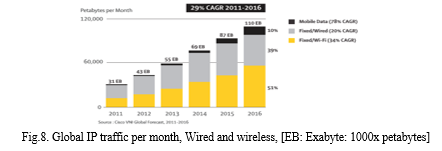

Conclusion
Optical fiber communication network is currently worked as essential supports for this 21st century digital era. It emphasizes the advantages of optical fiber communication system and various limitations associated with it. Then this paper compares Optical fiber communication system with electrical transmission system which is traditional system and with wireless system also. The focal point of the study discusses thoroughly about optical fiber communication system with its technology model, evolution history and breakthrough trend change. The table below summarizes how communication industry has shown tremendous growth under various businesses
References
[1] Prachi Sharma et al, “A Review of the Development in the Field of Fiber Optic Communication Systems”, International Journal of Emerging Technology and Advanced Engineering, Vol. 3, no. 5, pp. 113-119, 2013. [2] “Evolution of Optical Fiber Technologies” by Dr. Arvind Kumar Mishra, May 2013. [3] “Future Trends in Fiber Optics Communication” by Francis Idachaba, Dike U. Ike, and Orovwode Hope, WCE 2014, July 2 - 4, 2014, London, U.K. [4] M. Noshada, A. Rostami, “FWM minimization in WDM optical communication systems using the asymmetrical dispersion managed fibers”, International Journal for Light and Electron Optics, vol. 123, no. 9, pp. 758– 760, 2012. [5] Ogata Takaaki, “Recent Status and Trends in Optical Submarine Cable Systems”, NEC Technical Journal, Vol. 5 (1), pp. 4-7, 2010. [6] Franz Fidler, Markus Knapek, Joachim Horwath, and Walter R.Leeb, “Optical Communications for High-Altitude Platforms”, IEEE Journal of Selected Topics in Quantum Electronics, Vol. 16, no. 5, September/October 2010. [7] ARC Electronics. “Brief Overview of Fiber Optic Cable Advantages over copper”, the basics of fiber optic cable- an unpublished tutorial from http//www.arcelect.com/fibercable.htm assessed 12/12/2015.
Copyright
Copyright © 2024 Aarti Varshney, Vishal Goyal. This is an open access article distributed under the Creative Commons Attribution License, which permits unrestricted use, distribution, and reproduction in any medium, provided the original work is properly cited.

Download Paper
Paper Id : IJRASET58076
Publish Date : 2024-01-17
ISSN : 2321-9653
Publisher Name : IJRASET
DOI Link : Click Here
 Submit Paper Online
Submit Paper Online

